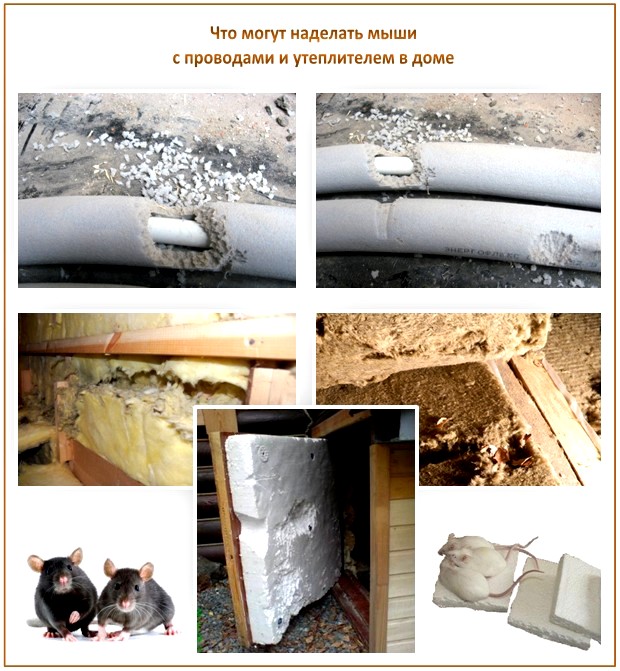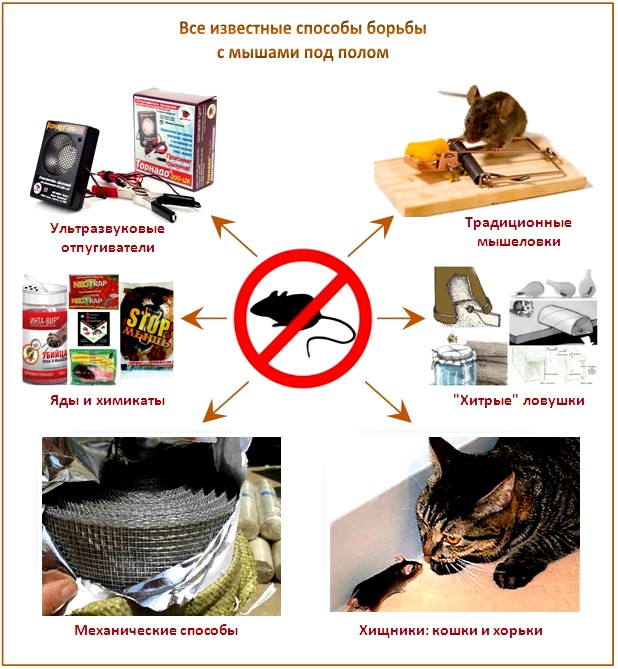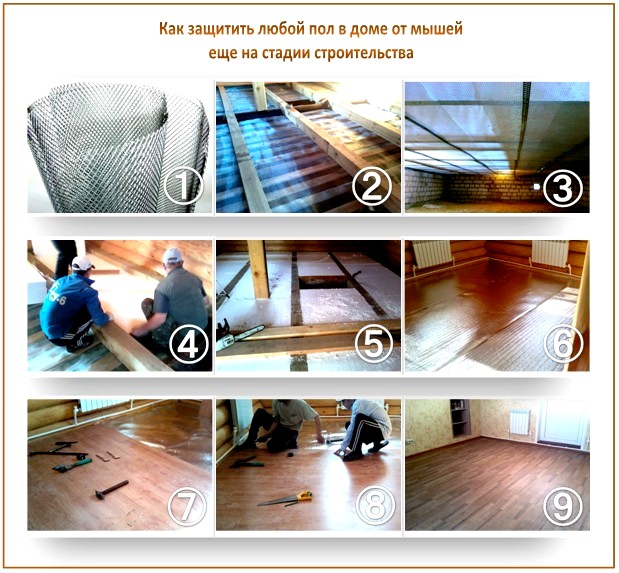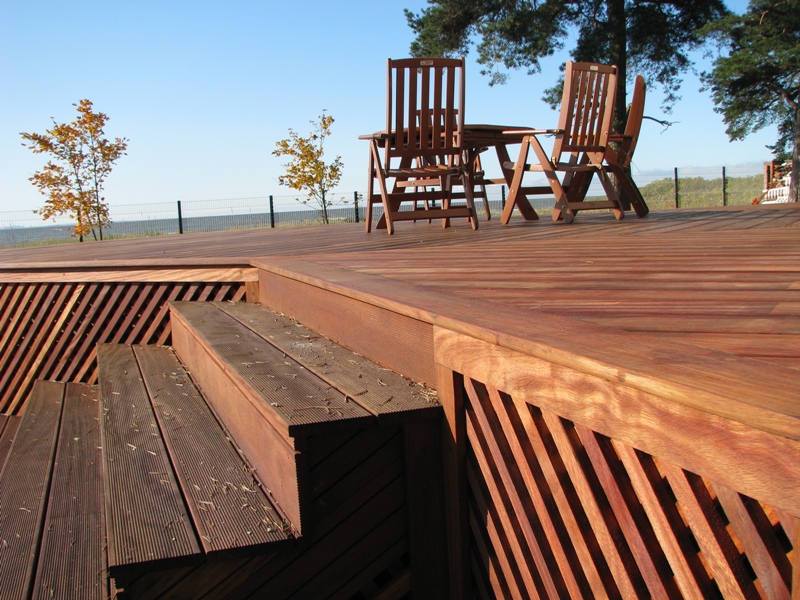Mice under the floor: an overview of the best options for getting rid of hated rodents
Noise and squeak at night, eaten up insulation in the floor, an unpleasant smell? You probably got mice. These, at first glance, harmless favorites of Disney cartoons are a real headache for all houses of all countries, for the solution of which every year new technologies are invented, and even new breeds of animals are bred. And what are the general methods of dealing with them? And how to protect an unattended bathhouse or a country house? Now we’ll find out everything.
Content
What threatens the invasion of mice?
So, let's look at the difficulties that ordinary home mice can create under the floor:
- Constant noise at night.
- Crumpled cables, wires and pipes from some materials.
- Insolvent turned into dust.
- A specific and not very pleasant "mouse" smell in the house.
- Mouse waste found in the morning where possible.
- Danger of contracting rodent-borne diseases.
And also such unpleasant phenomena as a dead mouse under the floor, which is not easy to find and pull out there.
Now imagine that in a year a female gives up to 7 mice in each of 10 annual offspring. Those. in 12 months, your house will already have 60-70 new rodents! And each mouse grows up within only three months, and also begins to multiply. At the same time, mice are fast animals: they can reach speeds of up to 12 km / h, jump up to 75 cm in length, and up to 40 cm in height. Just do not let this problem go by chance - they will also eat the house.
Where do the mice come from under the floor?
The main goal of mice is food. Secondary - in the house where food is, build nests and breed. And the smell of food mice feel for two kilometers! (Note, the bear is only a little more - for five). That is why if you leave your summer house or bathhouse closed for the season, remove everything that can attract these animals from there.
Especially “under the distribution” frame houses fall due to their design. Such a house is being built very quickly, fairly budgetally and at the same time it fully meets all the requirements. But the mice in its walls and floor are a real disaster. Rodent invasion of such a house may begin at the construction stage, but getting rid of such pests is difficult.
But even the strongest solid construction made of bricks or blocks also rarely succeeds in avoiding the neighborhood with tailed ones - because they like to settle under the floor. And, if the walls can still be somehow protected with metal sheets, then it is more difficult to drive the mouse out from under the floor. And with the advent of cold weather, this beast will find every opportunity to make its way underground.
Although the mice themselves are different. So, voles in the warm season make their nests in the open air - under the boards, by the trash. Until the fall, they actively multiply, and at the first cold weather go into any enclosed space. And they can even get to you under the floor through the ajar front door and right in front of the owners! But domestic mice from under the floor and do not particularly look out. Moreover, cats get used to the smell easily.
Insulation and rodents: is there a solution?
Let's immediately clarify - most modern heaters for flooring do not really eat mice, but they live peacefully in them. And in the soft, they also make nests.
Interesting fact: the teeth in mice grow throughout their lives. Moreover, if the mouse does not constantly gnaw something, then these teeth will grow in her upper jaw. Therefore, gnawing is a daily need for this animal. And even concrete walls can sharpen a mouse.
Most often, mice start up, oddly enough, it is in the foam. Moreover, they gnaw at him - but not with the goal of satiety, but with the goal of building convenient nests in it. And because manufacturers recommend warming the walls and floor with ecowool, which is more loose and creates an antiseptic environment. But her mice also bite, although not so willingly.
Indeed, as practice shows, under the floor, mice can wind up in ecowool, in polystyrene, and in almost any other insulation. Even in glass wool! True, it is worth noting that it is very difficult, almost impossible to bite ordinary plywood and OSB boards of a mouse. All because of the structural features of her teeth. As well as slabs that have a layered structure with wood chips directed in different directions.
The secret of survival of these animals in any conditions is their extreme unpretentiousness. Therefore, they bite their holes in anything, in one word.
Traditional methods of protecting the floor from mice
If you still have mice under the floor, you can also contact a professional service. They carry out a special treatment that allows you to forget about rodents for the whole year. This is the easiest, though not the best option. There are other traditional methods.
Frightening scents: from mint to scorched wool
When laying the floor, add ash, slag, tobacco dust, dry wormwood or peppermint to the insulation - mice really do not like it. Some also add red hot pepper or a lot of broken glass.
Moreover, the smell of dried mint acts on the mouse asphyxiating. For the time of your absence in the house, you can even hang this plant in various angles - this one really helps.
Underground mice do not like not only mint - but in general everything smells strongly and unpleasantly. The aroma of burnt wool is especially disgusting for them - some even fumigate the room with it, and the burnt remains are dumped under the floorboards. Mice do not like this smell and usually retire from such places.
Also, when building a house from blocks, builders often process them with solutions of borax or lime. All from the same.
Traps: modern and home-made
Most popular today are adhesive traps. So far the best reviews about ALT glue are not expensive and quite sticky. It must be applied to a piece of plywood in the form of a circle, and leave a drop in the very center. We put the bait on it, and if the mouse even touches the glue with just the tip of the tail, it will not go anywhere.
Note that wire traps-springs are less suitable for a private house in the fight against mice - if there are already many holes and moves near the house, then you will dig these pieces of iron in the area for a long time.
But, if rodents have already bred, such a fight with them can be exhausting.
Pesticides: the main thing is not to poison the cat!
But pesticides have a significant minus: firstly, they can accidentally poison a pet, and secondly, no matter how sellers say that the carcasses of mice are quickly mummified and do not emit odors, in fact, they decompose for a long time in hard to reach places and to live in this period in a house is impossible.
Therefore, if you use pesticides, then scatter them under the floor only at the beginning of autumn - when rodents are going to stand.
Ultrasonic repellers: both mice and cat
This is a new word in the fight against mice under the floor. After all, there are no barriers to ultrasound. So, they are small devices that, when turned on, produce a sound of frequency inaudible to humans, but for rodents, they are quite unpleasant and affect the nervous system.
When choosing such a device, one should carefully choose the manufacturer and not save, otherwise the cat may also run away from the house. And ultrasound repellers are not always safe for people. We can say that this issue has not been fully studied, and yet some part of the population hears a thin squeak when the device is turned on, which it should not a priori hear. Therefore, this method is more suitable for a bathhouse or a country house, where you do not come too often. Left - turned on the device, arrived - turned off for a while.
The assortment of modern repellers itself is very diverse - and among such devices there are a lot of those who act tangibly, but 100% do not give a result.
So, the most powerful repeller today is Spectrum, which covers up to 300 square meters. For the underground, this is the best choice: it works without interruptions for several years, normally tolerates the increased humidity of the basement and the voltage in the mains. If the electricity is turned off, then the device will turn on itself, and therefore it is convenient to install it in a country house or bathhouse, where you have been absent for months. But, the most important thing to do is to close all the gaps in the house and completely isolate the food. After all, even kapron covers on the banks of the mouse easily bite through - here you need more reliable protection.
Citizens recognize typhoons, Weitech WK-0300, WK-0600 CIX, Grad A-500 and GRAD A-1000 PRO as quite effective inhabitants. They have a fairly powerful expensive base, a wide radiation pattern and a constantly changing ultrasound frequency, which ensures that rodents are not used to it. The less popular are the Pestchaser 360 M +, Pestchaser 360, and CHISTON-2 360.
And the cheapest repellers are characterized by weaker technical stuffing and low power. Rodents get used to such quickly and on the first day. These are Weitech WK-0220, Pestchaser LS-968, Pestchaser AC / DC, and Weitech WK-0240.
If you decide to deal with mice under the floor in this way, be sure to study the certificates attached to the purchase. Otherwise, you can buy a fake.
Predators - biological weapons
So, the scariest animals for mice are cats and ferrets. And the latter are much more experienced and clever in this regard! Get such a favorite - you will be surprised.
As for cats, far from all breeds of this family love to catch mice. And cats are idlers at all. But rodents are more afraid not so much of a rare chance to get caught, but of the smell of the predator itself. Therefore, some craftsmen scatter cat hair under the floor - and this is an excellent and effective method.
You will also be interested to know that a cat is not just a predator that loves to eat mice. These are real biological weapons against the latter. So, in the excrement of a cat there are special substances that act on the consciousness of rodents, and they already behave more fearlessly - and come across easier (which is why catters who are not too hygienic often, having lost the same sense of danger, get into accidents more often than others - there are such research).
A breed of dogs such as the American Staff Terrier is also bred in America. These are real Pied Piper, and they are bred specifically for farmland instead of cats. They also catch mice remarkably, although they do not eat. Speaking of the breeds: the more decorative the cat, the less prone to natural hunting, and therefore it is better to give preference to the usual yard Murka. And finally, it is worth noting an interesting fact: most of all mice are afraid not of cats, but of rats. And in the house where one rat started, there are usually no mice.
Rodent protection under construction
Why exactly at this stage? Yes, because to prevent the invasion of rodents is much easier than then fight them. And the myths that for those who want to get into the house of mice there are no barriers - these are still myths. With a creative and attentive approach to this issue, you can completely achieve that such an attack never starts in your house or bathhouse.
But for starters, you can carefully study the current building codes and rules, which list the grilles, metal screens and other protection methods. But remember, when installing the metal profile from mice, it is necessary to leave a gap - so that the insulation does not get wet from the condensate.
Method # 1 - expanded clay castle
Here we are talking about the so-called "expanded clay castle", when the expanded clay layer is laid especially tightly and at least 10 cm thick. Here is a standard floor cake that is protected during construction of the house from mice:
- 1st layer: we put expanded clay (burnt clay) directly on the ground. The layer should be at least 30 cm. Cover with plastic wrap.
- 2nd layer: stacked with two layers of OSP-3 plate.
- 3rd layer: again we put expanded clay.
- 4th layer: cover with oriented particle boards saturated with synthetic wax and boric acid. These substances repel rodents well.
As you can see, nothing complicated.
Method # 2 - fine mesh
The simplest and most effective way of mechanical protection against mice even at the construction stage is a galvanized grid. It should be made of durable metal and with small cells. Much smaller than what you currently imagined. Now let’s explain why: the mouse’s skull has the property of “folding”, like a newborn’s, and therefore this animal will really crawl there, “where the pencil will crawl,” as biologists like to say.
So, it is advisable to lay the metal mesh during construction even on the rough floor and additionally wrap around the basement if you live in a private house. And how to equip the floors with it, you can consider in more detail on our photo instruction:
If possible, cover all corners (both floor, wall, and ceiling) with a grid, which is usually used for plaster. Do not miss a single junction.
Sometimes this material is protected from mice even after construction, when the problem with rodents becomes apparent. To do this, bury it around the foundation to a depth of 80 cm. If you notice already dug holes, then even deeper. And under the plinth of the plinth, lay the net at least a meter high.
The house foundation is also trimmed with a profiled sheet of 1.5 mm, made of structural steel. This is also a good additional protection.
Method # 3 - leave the mice under the floor
If you are satisfied that there will still be a small number of mice under the floor, but they will not penetrate the house itself, then make this cake:
- Step 1. Forget about the insulation. A floor without mice is a floor without any wat and polystyrene. Just make a shield - the floorboard right along the lags.
- Step 2. To prevent mice from entering the gap between the edge of the floor and the casing on the outside, cut 10 cm galvanized strips and pin them on top of the floor.
- Step 3. Close these strips with insulation and casing on top.
These are simple proven recipes. The main thing - do not give up!







10 comments